















Easy Breezy Russian Garb
from class taught at Gulf Wars XVI by
Master Mordak Timofe'ivich Rostovskogo and Lady Sofya la Rus
Introduction:
-
Many people seem to be interested in Russian personas, but they are intimidated by the garb - it looks too complicated, or too hot. But it's not - we'll show you how.
-
In these modern middle ages, nearly everyone starts on a shoestring budget. Another common experience is that we all seem to try a couple personas before we find the “right fit”. In this circumstance, most people don't want to invest much money in a persona that may be just a memory in six months, so we all start with T-tunics, or their female equivalent, chemises. Better yet, your Shire or Baronial Gold Key officer may have more than he or she wants to continue dragging around.
And a simple tunic, a pair of scissors, a measuring tape, and a needle/thread are all you need for your first Russian garment, or someone else's.
-
Russia is not the year-round icebox that many assume it to be. The climate in Moscow is similar to that in Minnesota, while Kiev is similar to Arkansas/Tennessee. So Russians had plenty of warm days to dress for
Russia has long been famous for its linen - the perfect summer fabric. Light-weight wools are excellent for summer wear. And Russians used a variety of cotton fabrics as early as the 14th or 15th century. And they were smart enough to know that fur linings were only for winter and cold weather.
Period Russian clothes are cut full and loose allowing fine ventilation. The "five layer rule" was only for the highest late-period nobility and only for formal occasions. (In Sofya's opinion.) And using a little creative license, even "five layers" can be manageable for summer events.
 Like many other medieval cultures, the Russians used a version of the T-tunic. This basic pattern can be modified to make almost any Russian garment - from a simple peasant shirt, to the tsar's coronation robe.
Like many other medieval cultures, the Russians used a version of the T-tunic. This basic pattern can be modified to make almost any Russian garment - from a simple peasant shirt, to the tsar's coronation robe.
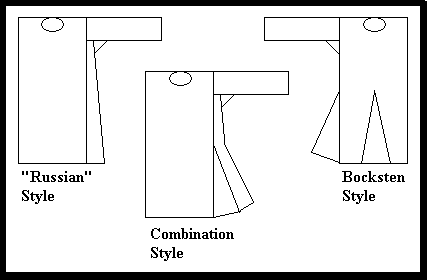
-
You don't have to be fabulous all at once. You can quickly make a simple tunic that is perfectly wearable (and quite attractive if fitted correctly and made of appropriate fabric) for that first event and add trim and other embellishments as time and inspiration allow.
-
This Russian-style T-tunic is the fundamental garment of all Russians, from the tsar at home to the peasant working in the field. It is knee length for men, ankle-length for women. Classically white/off-white with red embroidery trim at neckline, cuffs and hem, but other colors and simpler trim used also. Always belted.
So pull out a light-colored T-tunic out of your pile of hand-me-down garb, add a narrow belt and some red bias-tape trim, maybe even some red armpit squares, and away you go!
This is all you need to wear on a really hot day (well, men should usually have trousers, too. See below).
To beat the heat, make one with the lightest weight all-natural fabric you can find - use colored/patterned fabric for modesty, put in a yoke for strategic double coverage, or just wear it under a light overgarment. See below.


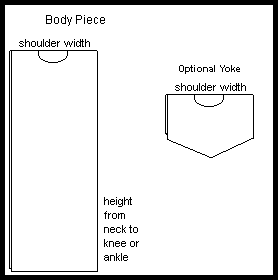
-
For men. Just simple drawstring pants. Skip the trousers if necessary on the very hottest days.

-
The next easiest garment to convert that old cotton tunic into is the caftan. All you need to do is cut it right up the center from bottom to neck, sew down the edges, and use a cloth sash or belt to keep the overlapped sides closed!
Fancier versions have a row of horizontal cloth strips on each side of the front opening, each one meeting the one opposite in the center and held shut with a button/loop.
Even fancier versions of either caftan or tunic have collars, usually a strip of fabric doubled over and sewn at the edge of the collar or shaped like a flattened banana with the shorter side sewn into the neckline. Another fancy addition could be a wide (3-12”) strip of fabric sewn to the edge of sleeves and/or the hem of the T-tunic. Just push the end of the sleeve up on your wrist and you will look like a period Russian of average means!
Versions of this garment were worn by both men and women. (But less common for women)
It would normally be worn over a shirt/chemise, but you could skip the undershirt on those really hot days. (And, of course, make it out of summer-weight fabrics.)
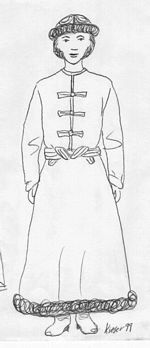
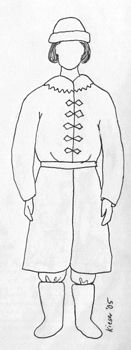
-
Women's overgarments are also mostly variations of the T-tunic and come in a wide variety. Most have wide trim, usually fabric, at the hem and down the center front. Many had buttons or ornamental bobs down the center of this front fabric from neck to hem. An old 60s-style necklace will provide all of these that you will need, fake metal or “wood” is better!
- You need a knee length tunic for the hip length version and an ankle length tunic for the mid-thigh length version. First, slit it up the front from hem to neckline. Next, slit the back from just below your shoulders to the hem and from armpit to armpit, forming a T. Measure the back slit, divide in half and cut each side around to the front slit. Sew each of these lower halves to each side in the back and then sew them together. Pin the center or the big loop of fabric in the center to the top part, in the center. Repeat with each side, separately, until the lower part is pinned to the upper part with many, many folds. Pin the folds flat (they should each be 1” wide) and sew them together. Then sew back across, pinning the folds flat to the upper part so they aren't so noticeable to you when you wear the jacket. Turn and finish the edges, add on a strip of fabric at the hem and/or cuffs, or even fur from a thrift store 1950s coat.
Navershnik:
- knee to calf length gown with wide elbow length sleeves. Just take a T-tunic of the appropriate length with slightly full sleeves and chop the sleeves to elbow length.
Letnik:
- loose, belted or unbelted ankle-length gown with wide angel-wing sleeves and contrasting edging. Made of linen and meant for summer wear (leto means summer in Russian). It's just a T-tunic with graceful, wide sleeves. Such a garment made of fine silk was worn for ceremonial occasions.
Panova:
- a wrap skirt - one to three rectangles of fabric (often checked or plaid) hanging lengthwise from the waist long enough to reach mid-calf or ankle, and wide enough together to reach around your waist. Sewn together only at the top edge (or just gather onto a drawstring) with a couple loops of thread and a cord or button to connect the two panels in front. If doing the three-panel version, one panel should hang straight down the back, with each of the other two over a thigh each. Nice to wear over a very light, yoked chemise. Earlier period.
Zapona:
- basically a sideless, sleeveless tabard a little shorter than the chemise that may have been worn by maidens in early period. Perfect to wear over that light, nearly sheer dress. Just a simple, narrow rectangle of fabric with a hole for your head, belted in place or pinned at the sides.
Dushegreya:
- a short women's jacket, with or without sleeves, generally hip or mid-thigh length and open in the front. It can be held closed by hand, with a couple buttons and/or loops at the top or along the entire opening. Or, you can just leave it open and unbuttoned! A fur collar from the thrift store can adds a lot of elegance. It's a Central Asian garment that Mordak conjectures that the Mongols brought with them. Its very comfortable, easy to make and a nice layer when nights cool off.
Sarafan:
- controversial sleeveless ankle-length overdress, resembles a longer version of the dushegreya without all the pleats and gathers. Later period garment. Another good cover-up option.
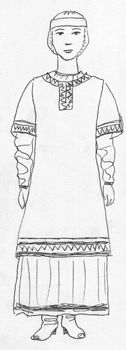
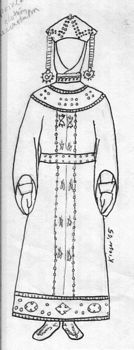

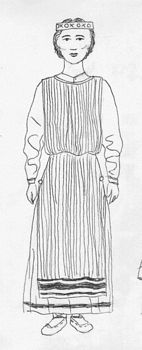
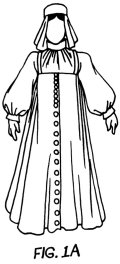
-
Your fur hat will look like one half of a football, more or less pointy as you wish, with a strip of fabric, an old fur collar or a piece of trim sewn at the edge and turned up on the outside of the hat. Russians also would sometime cut this strip from the edge straight to the hat and let the two sides hang open and kind of drooping to each side, with the center slit on the forehead. For nine out of ten events that is what I wear on my head. It's different, comfortable and easy to make.
For summer, skip the fur lining, or just use it on the cuff.
A hat that looks like a straw boater hat was found in Novgorod and dated to the 14th century.
Two different patterns for a fur hat.
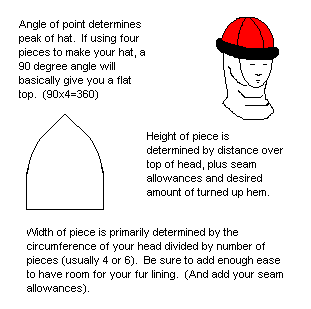
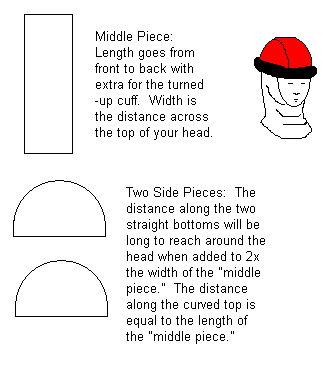
-
The forehead area of any headdress will be the most elaborately decorated part.
Maidens, i.e. unmarried women, don't need any headdress at all, but a simple fillet over loose hair or a single braid down the back is a nice touch. Take one of those buckram-and-wire bridal headdress blanks and wrap it with long strips of fabric left over from your dress.
Married/widowed/divorced women need to keep their hair covered. A plain white headscarf makes a quick simple "povoinik" cap (just make sure all loose ends are tucked away or you'll look like a modern babushka). I'll take a piece of ribbon or card-woven belt and tie it around the bottom edge of the cap for extra color.
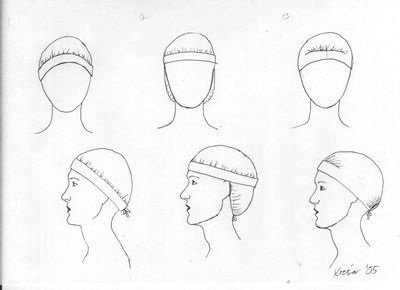
And over the cap, a rectangular headscarf is nice. A relatively small one (2ft x 2 1/2 ft) will just pin under the chin, which makes it easy to un-pin for a little extra ventilation in hot weather while still nicely shading the back of the neck. Bigger scarves (2ft x 5-6ft) can be wrapped more creatively.
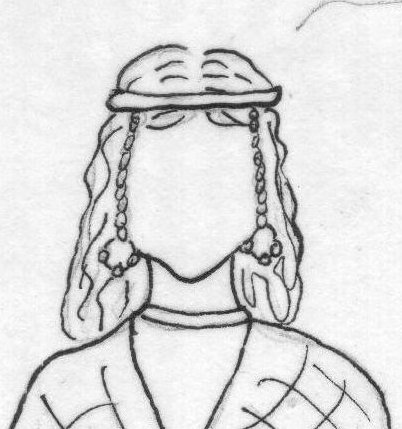
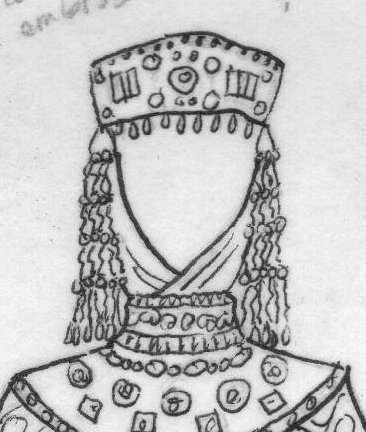
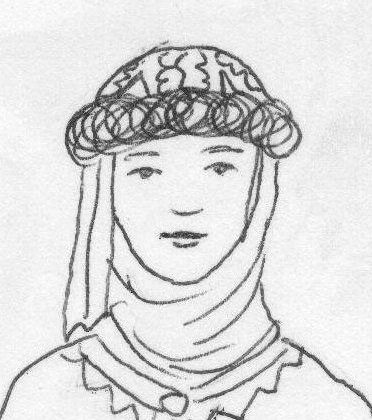
Fur hats can be just like the men's, and aren't that hard to wear in summer, since many of us have so much hair up there already. The nice thing is that they don't blow off or fall off like other hats tend to.
And that Novogorod "boater" hat didn't come with a label specifying if it was a men's or women's hat.
-
A couple T-tunics and you have a new wardrobe in an evening or two, probably for absolutely free! Be a Russian, then hand it off to a newcomer or interested friend in the local group.
COPYRIGHT (c) 2007 by Tim Nalley and Lisa Kies. You may make copies for personal use and to distribute for educational purposes but only if the article remains complete and entire with original authorship clearly noted.
Back to Russian Material

















